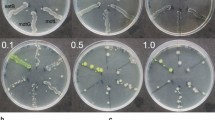Abstract
The bacterial ydcI gene encodes a highly conserved transcriptional regulatory protein found in a wide range of Gram-negative bacteria and is involved in a number of Salmonella enterica serovar Typhimurium phenotypes. Given its high conservation, the YdcI protein has the potential for studies and applications across bacterial genera. However, no studies have been performed with YdcI outside of S. Typhimurium. Here we report that different Gram-negative genera display dramatically different tolerances for YdcI expression. In non-tolerant genera, YdcI expression results in rapid loss of cell viability several log-fold in magnitude, and the viability loss is observed at YdcI levels that are physiologically relevant. The N-terminal and C-terminal halves can be exchanged between the S. Typhimurium and Escherichia coli YdcI proteins with the resulting proteins still displaying the differential tolerance phenotype. Comparison of YdcI expression from the respective chromosomal gene in S. Typhimurium and E. coli revealed much lower levels in E. coli suggesting that this species has evolved a lower endogenous YdcI expression level and does not tolerate increases above this level. Expression of YdcI resulted in increased sensitivity to a range of antibiotics indicating the possibility that this protein could augment antibacterial strategies in non-tolerant genera. Overall, the results indicate vastly different outcomes for YdcI expression depending on bacterial genus and unmask differences in YdcI expression, regulation, target interactions, and/or YdcI regulon activity in different bacteria. The results also impact future work on YdcI when the protein is being studied/expressed in different Gram-negative genera.






Similar content being viewed by others
References
Barreteau H, El Ghachi M, Barneoud-Arnoulet A, Sacco E, Touze T, Duche D, Gerard F, Brooks M, Patin D, Bouhss A, Blanot D, van Tilbeurgh H, Arthur M, Lloubes R, Mengin-Lecreulx D (2012) Characterization of colicin M and its orthologs targeting bacterial cell wall peptidoglycan biosynthesis. Microb Drug Resist 18:222–229
Bauer AW, Kirby WM, Sherris JC, Turck M (1966) Antibiotic susceptibility testing by a standardized single disk method. Am J Clin Pathol 45(4):493–496
Catalao MJ, Gil F, Moniz-Pereira J, Sao-Jose C, Pimentel M (2012) Diversity in bacterial lysis systems: bacteriophages show the way. FEMS Microbiol Rev 37(4):554–571
Eriksson S, Lucchini S, Thompson A, Rhen M, Hinton JC (2003) Unravelling the biology of macrophage infection by gene expression profiling of intracellular Salmonella enterica. Mol Microbiol 47(1):103–118
Filutowicz M, Burgess R, Gamelli RL, Heinemann JA, Kurenbach B, Rakowski SA, Shankar R (2008) Bacterial conjugation-based antimicrobial agents. Plasmid 60(1):38–44
Gulig PA, Curtiss R 3rd (1987) Plasmid-associated virulence of Salmonella typhimurium. Infect Immun 55(12):2891–2901
Jennings ME, Quick LN, Soni A, Davis RR, Crosby K, Ott CM, Nickerson CA, Wilson JW (2011) Characterization of the Salmonella enterica serovar Typhimurium ydcI gene, which encodes a conserved DNA binding protein required for full acid stress resistance. J Bacteriol 193(9):2208–2217
Quick LN, Shah A, Wilson JW (2010) A series of vectors with alternative antibiotic resistance markers for use in lambda Red recombination. J Microbiol Biotechnol 20(4):666–669
Shankar R, He LK, Szilagyi A, Muthu K, Gamelli RL, Filutowicz M, Wendt JL, Suzuki H, Dominguez M (2007) A novel antibacterial gene transfer treatment for multidrug-resistant Acinetobacter baumannii-induced burn sepsis. J Burn Care Res 28(1):6–12
Siddique A, Figurski DH (2002) The active partition gene incC of IncP plasmids is required for stable maintenance in a broad range of hosts. J Bacteriol 184(6):1788–1793
Uzzau S, Figueroa-Bossi N, Rubino S, Bossi L (2001) Epitope tagging of chromosomal genes in Salmonella. Proc Natl Acad Sci USA 98(26):15264–15269
Wilson JW, Coleman C, Nickerson CA (2007) Cloning and transfer of the Salmonella pathogenicity island 2 type III secretion system for studies of a range of Gram-negative genera. Appl Environ Microbiol 73(18):5911–5918
Wilson JW, Nickerson CA (2006) Cloning of a functional Salmonella SPI-1 type III secretion system and development of a method to create mutations and epitope fusions in the cloned genes. J Biotechnol 122(2):147–160
Wilson JW, Ott CM, Ramamurthy R, Porwollik S, McClelland M, Pierson DL, Nickerson CA (2002) Low-shear modeled microgravity alters the Salmonella enterica serovar typhimurium stress response in an RpoS-independent manner. Appl Environ Microbiol 68(11):5408–5416
Wilson JW, Ramamurthy R, Porwollik S, McClelland M, Hammond T, Allen P, Ott CM, Pierson DL, Nickerson CA (2002) Microarray analysis identifies Salmonella genes belonging to the low-shear modeled microgravity regulon. Proc Natl Acad Sci USA 99(21):13807–13812
Acknowledgments
We thank the following sources of support at Villanova University: Department of Biology, Office of Undergraduate Research (VURF program), Honors Program, and the Office of Research and Sponsored Projects.
Author information
Authors and Affiliations
Corresponding author
Electronic supplementary material
Below is the link to the electronic supplementary material.
Rights and permissions
About this article
Cite this article
Solomon, L., Shah, A., Hannagan, S. et al. Bacterial Genus-Specific Tolerance for YdcI Expression. Curr Microbiol 69, 640–648 (2014). https://doi.org/10.1007/s00284-014-0631-7
Received:
Accepted:
Published:
Issue Date:
DOI: https://doi.org/10.1007/s00284-014-0631-7




